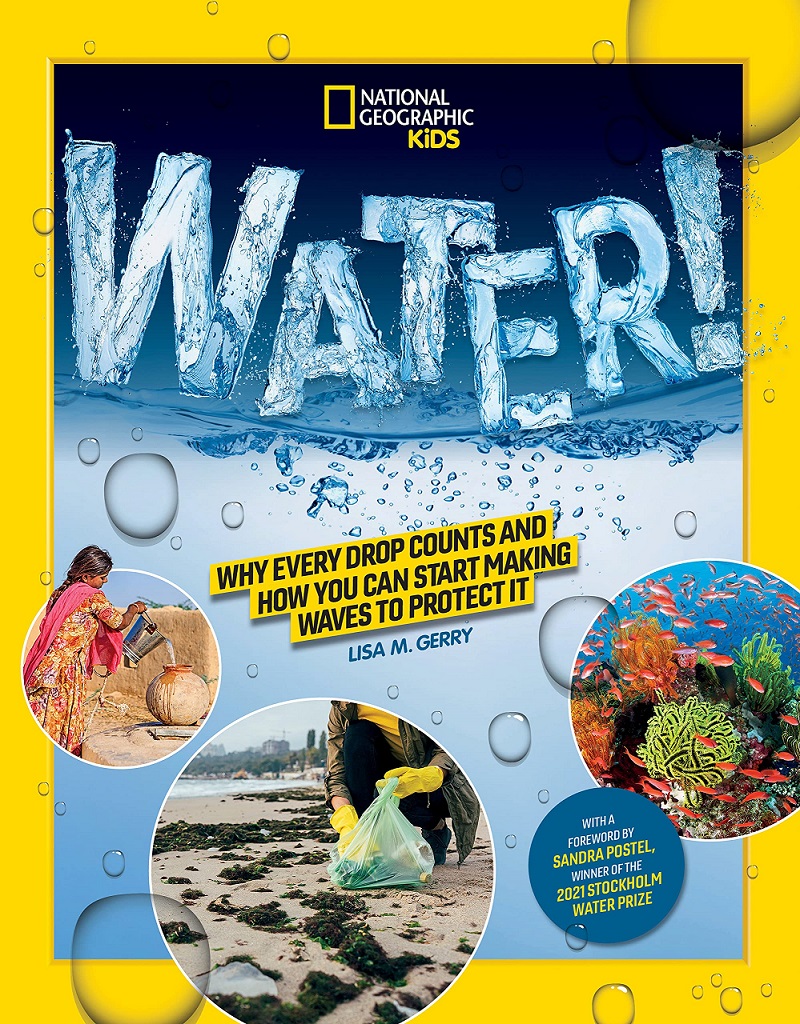Welcome to the Water! Blog Tour & Giveaway!
 Welcome to the blog tour for Water! Why Every Drop Counts and How You Can Start Making Waves to Protect It. Did you know the water in your glass could be the same water the dinosaurs drank? Dive in for a week’s worth of interviews with fascinating “Water Warriors”, profiles on the latest H20-saving tech and learn incredible facts about Earth’s water, the challenges facing it, and how your actions can help defend this precious resource.
Welcome to the blog tour for Water! Why Every Drop Counts and How You Can Start Making Waves to Protect It. Did you know the water in your glass could be the same water the dinosaurs drank? Dive in for a week’s worth of interviews with fascinating “Water Warriors”, profiles on the latest H20-saving tech and learn incredible facts about Earth’s water, the challenges facing it, and how your actions can help defend this precious resource.Sharing Secret Water Worlds:
A Q&A with “Water Warrior” and National Geographic Explorer, Jenny Adler
National Geographic Explorer Jenny Adler began her career as a marine biologist, studying the many organisms—both big and small—that live in the sea. But Jenny soon realized she wanted to do more than study the natural world; she wanted to share it and show it to people. She figured if she could communicate how cool these ecosystems are, people would begin to care about them and want to protect them! So that’s exactly what Jenny does. She uses her passion for underwater photography to introduce people to water worlds they might otherwise never see. One of these worlds is the Floridan aquifer. The Floridan aquifer stretches for more than 100,000 square miles (259,000 sq km) of the United States. It lies below all of Florida and parts of Alabama, Georgia, and South Carolina. The Floridan aquifer is a system of underground rock that is porous, meaning it has holes that water or air can pass through. As water trickles down from Earth’s surface, it is held underground in the limestone. The water in this rock, from tiny holes to huge passageways, make up the aquifer. And Jenny does something super special: She scuba dives and takes photos inside the aquifer’s underwater caves. How do you get into the aquifer?
Florida’s springs are like a bowl of clear freshwater. Then, somewhere in a spring—usually at the bottom or the side—there will be this black hole. That’s the spring vent and that’s where the water flows up from the aquifer. It’s kind of like this opening to this underground labyrinth of caves, which is pretty cool.
What inspired you to swim through that little hole and scuba dive in the aquifer?
Springs are really beautiful to swim in and I was swimming in them in all my spare time. I was learning so much about them and the curiosity was killing me. I thought, there are openings at the bottom of all these springs—I want to know what’s in there, and I want to see what’s it’s like.
So first you needed to become a certified cave diver and then you ventured into the aquifer. What is it like inside an aquifer?
People always think that aquifers are really colorful and bright because in the photos there might be 10 or 15 lights lighting them up. But in reality, in the aquifers, it’s the most pitch-dark place you could ever imagine. It’s like going into a closet, shutting the door, and putting a blanket over your head. There are no stars, there’s no moon, there’s no light sneaking in from anywhere—it’s absolutely, completely dark. So, when you’re in there, you really start to focus on other things, like the sound of the bubbles from your regulator.
What do you love about cave diving?
When I’m diving, I’m completely hyper-focused on what I’m doing, and my body and my mind are relaxed. I feel distracted above water sometimes, but underwater, it’s very peaceful. You feel completely weight - less, and the water is so clear that you almost can’t really tell that you’re in the water, so it feels like you’re hovering in outer space. It’s an amazing feeling.
What surprised you about the aquifer?
The caves really vary in size. At one spot, you might have to squeeze through an area where you don’t think you’re going to fit, and then the cave will open up into a room that’s big enough to fit a Boeing 747. The caves will go from being huge to tiny and from rock that’s full of holes like Swiss cheese to rock that’s really smooth. As I experienced so many different parts of it, I started to understand how complex the world is beneath our feet. It’s really rewarding and also sort of mind-blowing.
Are there fish and other living things in there?
In the springs there is a ton of life, but once you enter the caves where it’s dark, there isn’t much that can survive there. But there are these cool cave crayfish and amphipods that live in the caves. Most of them are albino; they’re completely white, and they’ve adapted to live in the cave.
How did swimming through the aquifer affect the way you think about how you use water?
It made me realize how close we are to our water, and how crucial it is that we protect it. What we do at the surface has a huge impact on the water beneath our feet.
Buy | Buy on Bookshop.org | Add to GoodReads
About Water! Why Every Drop Counts and
How You Can Start Making Waves to Protect It
(ages 8-12, Paperback, National Geographic Kids Books)
Did you know the water in your glass could be the same water the dinosaurs drank? Discover more incredible facts about Earth’s water, the challenges facing it, and how your actions can help defend this precious resource. No doubt about it, water is fascinating. It’s also essential. But our planet is facing some serious water problems: Drinkable water isn’t easily accessible to everyone, the demands for water around the globe are increasing while the supply is limited, and some human actions are causing disastrous ripple effects downstream for ecosystems and the animals that live in them. Fortunately, there is hope! And that’s where this book comes in. By learning the ins and outs of important water issues and making small but powerful changes in our daily life, we can help protect the water that connects us all on our beautiful blue planet. Features include:- What kids can do right now to combat climate change
- How to make a water filter at home and other fun activities
- How small changes in your daily routine can equal big water savings
- Q&A's with "Water Warriors" from around the world
- Special reports on "pulled-from-the-headlines" events that have recently impacted water and water supply, like the impact of war on water supply, the socio-economic implications of the water issues in Flint, MI, and how the residents of Cape Town South Africa pulled together to avoid "Day Zero."
About the Author:
Lisa M. Gerry is a writer and reporter who began her career as an intern at National Geographic Traveler magazine. She has since authored numerous books for National Geographic Kids, including Puppy Love and several installments of the 100 Things to . . . series. She has also worked as a writer for Time, Forbes, and Business Insider.
About the Expert Contributor:
SANDRA POSTEL (expert contributor) directs the Global Water Policy Project and is a National Geographic Explorer. She is a frequent lecturer, author, and consultant on global water issues, and in 2021, she won the prestigious Stockholm Water Prize, often described as the Nobel Prize for water. She is the author of Replenish: The Virtuous Cycle of Water and Prosperity; Pillar of Sand: Can the Irrigation Miracle Last?;and Last Oasis: Facing Water Scarcity, which appears in eight languages and was the basis for a PBS documentary.
GIVEAWAY
- One (1) winner will receive a copy of Water!
- US/Can only
- Ends 5/7 at 11:59 pm ET
- Enter via the Rafflecopter below
- Visit the other stops on the tour for more chances to win!
-
Blog Tour Schedule:
April 24th — YA Book Nerd
April 25th — Chat With Vera
April 26th – Always in the Middle
April 27th -- YA Books Central
April 28th — Pragmatic Mom





No comments:
Post a Comment